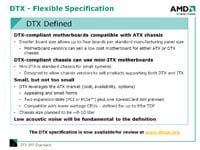Introduction and Background
It was back in January of this year at the Consumer Electronics Show that AMD first revealed their plans for the DTX open industry standard for small form factor computers. The focus of those early briefings was to explain AMD’s vision for interoperable small form factor systems. As it stands today, most SFF systems from large companies like Dell and HP are proprietary designs and only a select few parts can be swapped between them. On the do-it-yourself front, we’ve got form factors like Micro-ATX, Mini-ITX and SFF barebones systems from major players like Shuttle, Asus and MSI, but again, for the most part you can’t take parts from one company’s SFF design and use it in another’s. If all goes to plan and AMD’s vision for DTX comes to fruition, there will be a set of industry standards for chassis, power supplies, and motherboards which would not only make it possible for larger companies to more quickly introduce small form factor designs, but do-it-yourselfers would have an array of off the shelf components to choose from as well. To give us a glimpse into the future of DTX, AMD sent in an early prototype system for evaluation. However, before we show you the actual hardware, we’d like to give you a bit more background on DTX. First of all, if you’re wondering where the name comes from, it is simply a natural progression from ATX and BTX. The DTX mechanical interface specifications were developed to define location of things like mounting points, chassis volume, I/O, and keep-out areas for motherboards. As of today, the DTX specification has provisions for two motherboard sizes, full DTX and Mini-DTX. According to the current spec, DTX allows up to four motherboards to be produced per standard printed circuit board manufacturing panel sizes and Mini-DTX allows up to six. We should also note that DTX motherboard size and mounting specifications are designed to be compatible with existing ATX chassis specifications. And Mini-ITX motherboard size specifications are also compatible with DTX chassis specifications. Along with the general DTX specification, AMD has also developed mechanical reference designs for a DTX compliant chassis and motherboard. A small form-factor DTX chassis calls for 7.7 liters or more of inner volume, while mini-DTX requires only 1.5 liters or more.










